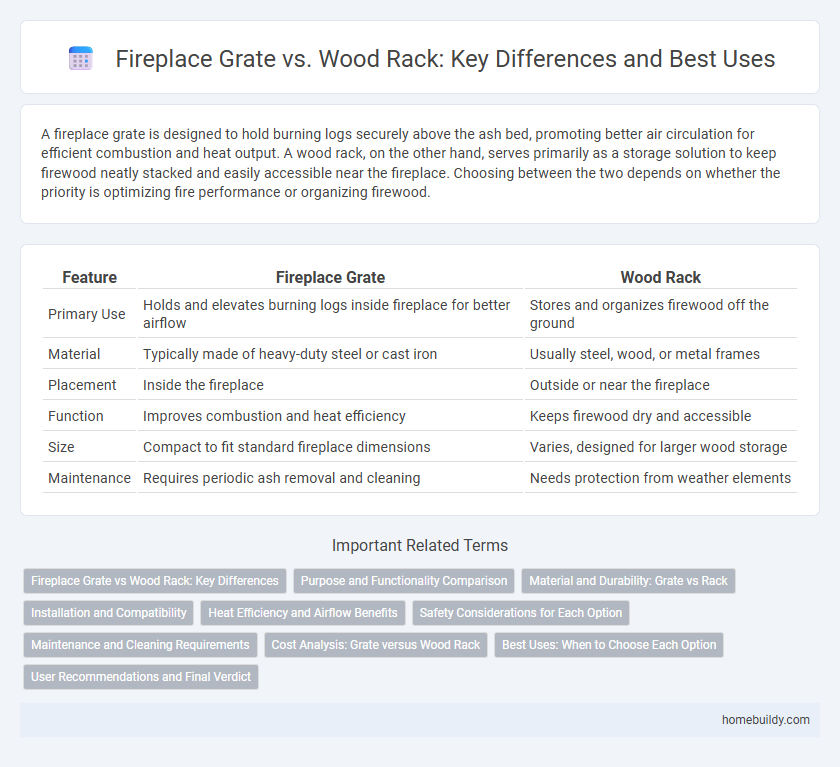A fireplace grate is designed to hold burning logs securely above the ash bed, promoting better air circulation for efficient combustion and heat output. A wood rack, on the other hand, serves primarily as a storage solution to keep firewood neatly stacked and easily accessible near the fireplace. Choosing between the two depends on whether the priority is optimizing fire performance or organizing firewood.
Table of Comparison
| Feature | Fireplace Grate | Wood Rack |
|---|---|---|
| Primary Use | Holds and elevates burning logs inside fireplace for better airflow | Stores and organizes firewood off the ground |
| Material | Typically made of heavy-duty steel or cast iron | Usually steel, wood, or metal frames |
| Placement | Inside the fireplace | Outside or near the fireplace |
| Function | Improves combustion and heat efficiency | Keeps firewood dry and accessible |
| Size | Compact to fit standard fireplace dimensions | Varies, designed for larger wood storage |
| Maintenance | Requires periodic ash removal and cleaning | Needs protection from weather elements |
Fireplace Grate vs Wood Rack: Key Differences
Fireplace grates are designed to elevate firewood, improving airflow and combustion efficiency, while wood racks primarily serve as storage solutions for organizing and keeping firewood dry. Grates are typically made of heavy-duty metal to withstand high heat directly under the fire, whereas wood racks are often constructed from metal or wood for outdoor or indoor wood stacking. The key difference lies in functionality: fireplace grates enhance the burning process inside the hearth, whereas wood racks focus on convenient and protective wood storage.
Purpose and Functionality Comparison
A fireplace grate is designed to elevate firewood for improved airflow and efficient burning, enhancing heat output and reducing smoke. In contrast, a wood rack primarily serves as storage, keeping logs organized and dry but does not contribute to the burning process. Fireplaces equipped with grates experience better combustion performance compared to setups relying solely on wood racks.
Material and Durability: Grate vs Rack
Fireplace grates are typically constructed from heavy-duty cast iron or steel, designed to withstand high temperatures and direct exposure to fire, ensuring long-lasting durability. Wood racks are usually made from lighter materials such as wrought iron or stainless steel, prioritizing storage capacity and resistance to rust but not intended for direct exposure to flames. The material strength and heat-resistant properties of fireplace grates make them more durable under extreme heat conditions compared to wood racks, which are optimized for organizing and protecting firewood away from the fire.
Installation and Compatibility
A fireplace grate is designed to fit securely within the firebox, allowing proper airflow to enhance combustion and reduce smoke, whereas a wood rack primarily serves as storage outside the fireplace. Installation of a fireplace grate is straightforward, often requiring no tools, as it rests directly on the firebox floor, compatible with most standard fireplace dimensions. Wood racks, by contrast, are not compatible for use inside the fireplace due to material and design differences, making them unsuitable for burning purposes.
Heat Efficiency and Airflow Benefits
A fireplace grate enhances heat efficiency by elevating wood, allowing air to circulate freely beneath the fire, which promotes more complete combustion and consistent heat output. In contrast, a wood rack primarily stores logs without optimizing airflow, resulting in slower burning and reduced heat generation. By improving airflow, a fireplace grate reduces smoke and increases fuel efficiency, making it a superior choice for maintaining a warm and clean-burning fire.
Safety Considerations for Each Option
Fireplace grates are designed to securely hold burning logs, promoting better airflow and reducing the risk of log rolling or embers falling out, enhancing safety during use. Wood racks provide a convenient storage solution but do not offer the same stability or containment for burning wood, increasing the potential for sparks or ash to escape when placing logs into the fire. Choosing a fireplace grate over a wood rack ensures safer combustion management and reduces fire hazards in the hearth area.
Maintenance and Cleaning Requirements
Fireplace grates require regular cleaning to remove ash and soot, ensuring efficient airflow and combustion, while wood racks primarily need occasional dusting and debris removal to maintain appearance. Grates are often made of heavy-duty metal that withstands high heat and may require rust prevention treatments, unlike wood racks that need protection from moisture to avoid warping. Proper maintenance of fireplace grates extends their durability and optimal function compared to the simpler upkeep of wood racks focused on storage cleanliness.
Cost Analysis: Grate versus Wood Rack
Fireplace grates typically cost between $30 and $100, offering durable metal construction designed to improve airflow and combustion efficiency. Wood racks, priced around $20 to $60, primarily serve as storage solutions without enhancing fire performance. Investing in a fireplace grate provides better heat output and longer-lasting materials, while wood racks focus on convenience and cost-effectiveness for wood organization.
Best Uses: When to Choose Each Option
A fireplace grate is ideal for containing and elevating wood inside a fireplace, promoting better airflow and more efficient burning. A wood rack, on the other hand, is best for storing and organizing firewood outside or near the fireplace, keeping logs dry and accessible. Choose a fireplace grate when your goal is to improve fire performance, while a wood rack is better for firewood storage and preparation.
User Recommendations and Final Verdict
Fireplace grates provide better airflow and combustion efficiency compared to wood racks, making them ideal for users seeking a hotter, cleaner burn. Wood racks are suitable for those prioritizing easy wood storage and organization but offer limited combustion benefits. For optimal fireplace performance, users should opt for a sturdy cast iron grate designed to fit their hearth dimensions.
fireplace grate vs wood rack Infographic

 homebuildy.com
homebuildy.com